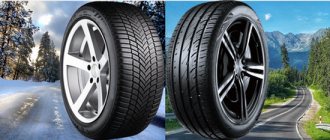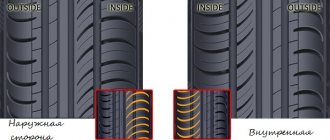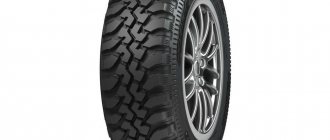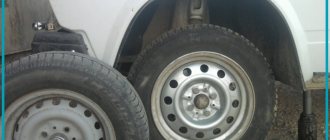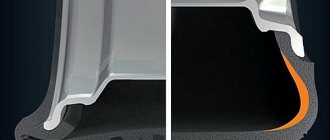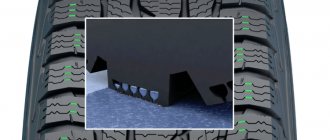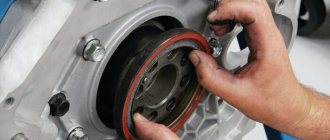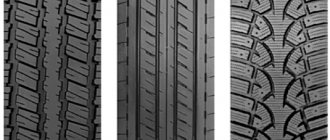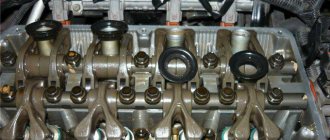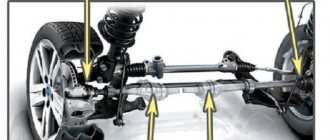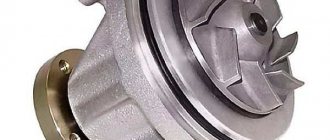Rubber for a car is like shoes for a person. In winter we wear boots, and in summer we wear sandals - that’s right, it’s normal. You won't be able to wear any of these pairs all year round. You can choose, for example, sneakers that can be worn regardless of the season. Yes, it will be inconvenient and uncomfortable, but you will be able to save money on buying new shoes. It's the same with all-season tires. Choosing tires for every motorist is always a difficult task. It is necessary to take into account many parameters, including the weather conditions in which the wheels will be used. Many drivers have two sets of tires: summer and winter. It's expensive, but reliable. Manufacturers have created a universal version that is suitable for winter and summer use. Is it good, safe and reliable? How are such protectors selected?
The right choice of all-season tires.
All-season tires: pros and cons
People with a positive attitude towards this type of tire confirm their attitude with the following data:
- compared to the studded version - this is a lower noise level (on dry asphalt);
- The cost is quite comparable to summer tires;
- there is no need to replace the complete set.
Pessimists, in turn, argue as follows:
- on hard road surfaces, the savings from the purchase are “eaten up” by the need for frequent renewal (due to a decrease in wear life);
- narrow recommended operating temperature range, which excessively reduces the period of use and makes them unsuitable for a wide range of motorists from Russia;
- The “extra” supply of elasticity in all-season tires is of poor service when braking on dry asphalt;
- risky for inexperienced drivers, especially on winter roads;
- cannot be used for racing vehicles.
All-season tires are the “arithmetic mean” option between summer tires and winter tires.
Firstly, they must be hard enough to rush along the asphalt track at the permitted speed. Secondly, the rubber must have elasticity in order to maintain a contact patch with the road surface on a slippery road.
The performance indicators of all-season tires can be characterized as: “Neither good nor bad.” This follows from the following:
- The braking process on an icy road with universal tires is worse than with winter tires;
- grip on asphalt (wet or dry) is less strong than that of summer “shoes”;
- the ability to overcome areas with melting snow is much less pronounced than with specialized products.
All-season tires differ in tread pattern from both tires for cold periods and those designed for hot weather. Compared to the first option, there are fewer protrusions. They are distributed at large intervals over the base area.
All-season tires are a compromise solution. They “borrowed” a rounded transition from the tread to the sidewall from summer tires, and wide and deep slots in the tread (lamellas) from winter tires. Ideal for clean urban highways, government highways, and privately owned roads.
All-season tires, depending on the intensity of use, last 3-4 periods, after which the protruding parts wear off, and it’s time to get new ones.
Protector Features
The directional pattern is suitable for driving on wet road surfaces. Therefore, for areas with rainy weather, this option will be the best. Thanks to the special arrangement of the grooves, the tire effectively removes water from the point of contact of the wheel with the road. In this case, the formation of a water wedge and, accordingly, aquaplaning is prevented. But it is important to note that the installation of this type of tire must be done correctly, otherwise the tire will do exactly the opposite. A special arrow shown on the surface of the product will help you install the tires correctly.
Non-directional tread is more common, as evidenced by numerous reviews. All-season tires of this type are characterized by maintaining their tread properties, regardless of the direction of rotation of the wheel. The car is held equally stable both when moving forward and backward. The peculiarity of the symmetrical pattern is that it is the same on the outside and inside of the tire. The asymmetrical version is distinguished by the visual division of the tire into two parts. The inner one is designed to conquer wet road surfaces, while the outer one performs well when driving on dry asphalt.
Marking of all-season tires Kama
It is worth noting that the marking of Kama all-season tires differs from the marking of other tires for passenger cars of this manufacturer.
The main differences are the pictograms made in the form of a snowflake, rain and sun. Some models of tires may also have letter designations in the form of inscriptions such as All Season, AS or AGT (All Grip Traction). All Season or AS are two variants of the same designation, which translates as all-season tires. AGT or All Grip Traction also means that the buyer has all-season tires. Also, certain all-season models may be marked AW (All Weather), indicating that the tires can be used in any weather.
At the same time, when snow falls and immediately melts, mud, puddles, slight frosts at night - all this is normal. The rigidity of the rubber compound also helps to drive the car not on a smooth asphalt surface, but on off-road or dirt roads. It is here that the tires of this manufacturer have proven themselves only from the best side.
First of all, the manufacturer’s logo is indicated on the side, followed by the designation of the materials used and their number of layers. If a tire has a directional tread pattern, this may be indicated by an arrow, in some cases duplicated by the inscription Rotation. The mandatory marking also includes the radial designation of the tire and the size designation, which fully complies with the markings accepted throughout the world.
Next you can see the designation in the form of a load index, which is often made in the form of a two-digit number in kilograms. In addition, the speed category, designations of certificates of conformity and regulatory documents according to which such tires were manufactured must be indicated. Additionally, the maximum load at maximum pressure is indicated. The driver can decipher this marking in the inscription MAX. LOAD and MAX PRESS.
Since all-season tires often wear out very quickly, the manufacturer labels them with the abbreviation TWI. This is where the wear indicator is located. in the four-digit digital code, as on other tires, the production date is encrypted, indicating the week and year of manufacture, and further mixed designations in the form of numbers and letters usually determine the model name.
Considering all of the above, it is not so difficult to understand what exactly these or other pictograms and inscriptions mean. And any car owner can easily choose tires with optimal characteristics for themselves, without relying on the opinions of friends and sellers who always try to sell goods in a higher price segment.
Load index
Along with the speed category, tire manufacturers put down two more numbers - the maximum load index. This parameter means that the tire is capable of traveling under the specified weight on one wheel, subject to maximum pressure. The indicator is indicated in kilopascals closer to the inner radius.
The higher the indicator, the greater the load that the wheel can carry. The minimum value in the industry is 1 - 46.2 kg per wheel, and the maximum figure is 279 - 13.6 tons per cylinder.
Summer tire in winter
These are tires for extremely warm temperatures, they should be rigid and relatively light, they should not have a rough and high tread, but effectively remove moisture. A hard tire in summer is a salvation, it “doesn’t melt or float” at above-zero temperatures, hard compounds are used to the maximum, heating up from hot asphalt, the tire effectively engages with the road surface, and there is no increased wear. However, in winter (already at zero), such rubber begins to harden, in addition to the fact that it itself is “hard,” under the influence of negative temperatures it becomes even harder, the tread cannot effectively adhere to the road surface (it practically does not wrinkle), and Even more so when dealing with snow or ice, such a tire literally rolls like “on skates”, the braking distance increases and the grip on the road deteriorates.
All-season tires pros and cons
All-season tires pros and cons
Pros and cons of all-season tires There are different opinions about all-season tires: some think such tires don’t exist, others say that it’s not real winter now. Drivers know that tires can be all-season, summer and winter. They differ in design, rubber mixture, and tread pattern.
Winter tires are softer, increase grip on icy asphalt, and wear out quickly when driving. Summer and winter tires differ in tread pattern and composition. All-season tires, a way to save money, buy one instead of two sets. In terms of driving performance, such tires are inferior to winter tires in the cold season and summer tires when it is warm. The disadvantage of all-season tires is that they are very noisy when operating.
All-season tires pros and cons
According to motorists, all-season use does not give good results either in winter or in summer. Comparing all the pros and cons, the best solution is to use seasonal tires. Tires of this group are well suited for driving on dry and wet roads, and are characterized by satisfactory adaptation to the road in winter. An all-season tire is characterized by a more branched tread pattern, the elements of which are separated by grooves of different widths. On the details of the tread pattern there are small slots with an additional micro-pattern. All-season tires can provide a decent level of safety in the winter and an excellent level of comfort on the road in the summer.
All-season tires: pros and consVery often, car enthusiasts think about the question of whether or not to purchase all-season tires. The advantage of such a tire is the price and maintenance, which are significantly less than other types of tires. When the seasons change, you don’t need to go to a tire shop to “change the shoes” of your car. Accordingly, both money and time are saved. When using such tires, you save space in the garage for different tires for each season. Another advantage is the savings on re-flashing the car, which costs money. The service life reaches several years.
All-season tires: pros and cons According to their parameters, all-season tires are inferior to summer and winter tires; they are something in between. They are good to use for short trips, or for those regions where the summer temperature is no more than 40 degrees, and in winter no lower than 5 degrees. The unsafety of these tires can be attributed to the disadvantages of using them. Many accidents on the roads happen on vehicles with such tires. The car is harder to drive with them. Almost all new cars are equipped with all-season tires. Manufacturers claim that all-season tires provide good traction, regardless of the time of year. The correct choice of tires depends on the technical characteristics of a particular type of car. Manufacturers recommend adhering to the following parameters: size, permissible speed, maximum load, installation rules. Such requirements are laid out in the machine operating manual.
Whether this type of tire is suitable for your car should be determined by paying attention to their markings. All information is indicated on the sidewall by the manufacturer with alphanumeric indices, information labels, pictograms
All-season tires: pros and cons In order to choose the right all-season tires for your car, you should decide on the operating features of the car: what the weather is like in the area where you live, where the motorist usually goes. The main aspect of proper tire operation is their correct installation. This will be done most efficiently by a car service employee.
All-season tires pros and cons
If the choice is made and the decision is to purchase all-season tires, you should install them. You need to make an appointment for tire fitting to avoid standing in lines. They must be used carefully to increase their service life. When they become non-working, it is better to send them to tire stations for recycling. After processing, they are used for new tires. All-season tires pros and cons
Dimensions
The size of all-season tires produced depends on the vehicles they are intended for. So for SUVs and crossovers, the most popular ramps are from R16 to R23. Passenger cars use smaller diameter tires from R13 to R21. You can see the main tire sizes in the table below.
Table - Main dimensions of all-season tires.
| 13» | 175/70 R13 82R |
| 14» | 155/65R14 75R |
| 14» | 175/65 R14 86R XL |
| 14» | 185/65 R14 90R XL |
| 15» | 165/60 R15 81R XL |
| 15» | 175/65 R15 88R XL |
| 15» | 185/55 R15 86R XL |
| 15» | 185/60 R15 88R XL |
| 15» | 185/65 R15 92R XL |
| 15» | 195/55 R15 89R XL |
| 15» | 195/60 R15 92R XL |
| 15» | 195/65 R15 95R XL |
| 15» | 205/65 R15 99R XL |
| 16» | 195/50 R16 88R XL |
| 16» | 195/55 R16 91R XL |
| 16» | 195/60 R16 93R XL |
| 16» | 205/55 R16 91R Flat |
| 16» | 205/55 R16 94R XL |
| 16» | 205/60 R16 92R Flat |
| 16» | 205/65 R16 96R XL |
| 16» | 205/65 R16 99R XL |
| 16» | 215/55 R16 97R XL |
| 16» | 215/60 R16 99R XL |
| 16» | 225/50 R16 96R XL |
| 16» | 225/55 R16 99R XL |
| 16» | 225/60 R16 102R XL |
| 16» | 235/60 R16 104R XL |
| 17» | 205/50 R17 89R Flat |
| 17» | 205/50 R17 93R XL |
| 17» | 205/55 R17 95R XL |
| 17» | 205/55 R17 95R XL F |
| 17» | 215/40 R17 87R XL |
| 17» | 215/45 R17 91R XL |
| 17» | 215/50 R17 95R XL |
| 17» | 225/45 R17 91R Flat |
| 17» | 225/45 R17 94R XL |
| 17» | 225/50 R17 94R Flat |
| 17» | 225/50 R17 98R XL |
| 17» | 225/55 R17 101R XL |
| 17» | 225/55 R17 97R Flat |
| 17» | 235/45 R17 97R XL |
| 17» | 235/50 R17 100R XL |
| 17» | 235/55 R17 103R XL |
| 17» | 245/45 R17 99R XL |
| 18» | 225/40 R18 92R XL |
| 18» | 225/45 R18 95R XL |
| 18» | 225/45 R18 95R XL F |
| 18» | 235/50 R18 95R XL Flat |
| 18» | 225/50 R18 99R XL |
| 18» | 235/40 R18 95R XL |
| 18» | 235/45 R18 98R XL |
| 18» | 235/50 R18 101R XL |
| 18» | 245/40 R18 97R XL |
| 18» | 245/45 R18 100R XL |
| 18» | 245/50 R18 100R XL Flat |
| 18» | 245/50 R18 104R XL |
| 18» | 255/45 R18 103R XL |
| 19» | 155/70 R19 88Q XL |
| 19» | 255/40 R19 93R XL |
| 19» | 225/45 R19 96R XL |
| 19» | 245/35 R19 93R XL |
| 19» | 245/40 R19 98R XL |
| 19» | 255/45 R19 102R XL |
| 19» | 255/35 R19 96R XL |
| 19» | 255/40 R19 100R XL |
| 19» | 255/45 R19 104R XL |
| 20» | 195/55 R20 95R XL |
| 20» | 245/40 R20 99R XL |
| 20» | 255/35 R20 97R XL |
| 20» | 285/30 R20 99R XL |
| 21» | 245/35 R21 96R XL |
Advantages and disadvantages
So, the main advantages of all-season tires can be reduced to the following qualities:
- savings due to the fact that there is no need to buy two sets. In addition, they require storage, “changing shoes,” etc.;
- in winter, such tires certainly behave better than regular summer tires;
- Unlike winter studded ones, universal ones do not have such a high noise level.
Now it would be fair to note what are the disadvantages of such a solution:
- All-season tires do not guarantee such traction when moving on ice and snow;
- Such products are too hard in frosty weather, and are excessively soft in hot weather.
All-season tires pros and cons
Depending on the part of the world the driver lives in, seasonal changes can be extreme or subtle. A number of regions of the Russian Federation have a temperate climate with warm, rainy summers, while other regions have very warm summers but are followed by long, cold winters. Drivers repeatedly ask themselves: are all-season tires suitable for use and how do they differ from other types of tires?
In this article we will describe what all-season tires are, as well as their main advantages and disadvantages.
What tires are considered all-season?
These tires are designed to perform well on the road in moderate weather conditions. If we compare such tires with summer or winter tires, we can say that all-season tires have better handling in a variety of weather conditions and are universal. However, such tires do not perform well in cold or hot weather.
Pros of all-season tires
All-season tires have a number of advantages, thanks to which drivers choose them, such advantages include:
Selection for SUV or crossover
We told you how to distinguish winter tires from summer tires - by the snowflake icon. However, to choose shoes for a non-trivial car, this knowledge may not be enough. When purchasing wheels for a crossover, you should imagine where the car will spend most of its time. If in the city, then standard tires with the designation AW (All Weather or Aqua - improved drainage and increased resistance to aquaplaning) are a good choice.
If the car goes beyond the definition of an SUV and you are planning trips into nature, then it is better to give preference to sets with a developed tire tread, improved lugs and increased cross-country ability. Such kits are designated by the letters AT - All Terrain.
For real off-road vehicles, special tires like Bridgestone Dueler are used, which have proven themselves in combat conditions and have high load resistance and excellent grip. This set is more expensive than the standard one, but its price is justified by its excellent qualities.
PROMOTION: SALE OF NEW CAR 2022 PRODUCTION
Pros and cons of all-season tires
What tires to put on your car in winter. This issue is being addressed by all car enthusiasts in our country. With the possible exception of the southernmost regions, where snowfall and ice formation are extremely rare phenomena. And in the northern regions, motorists have to drive around on winter tires most of the year. The question, at first glance, is resolved simply. In summer, you must drive a car on summer tires, and in winter, accordingly, on winter tires. But there is another option, to use all-season tires for winter and summer. In order to decide whether it is worth installing these tires on your car, we will consider all the pros and cons of all-season tires.
Versatility
As already mentioned, all-season tires are suitable for use in both summer and winter. They are designed to be used in dry and wet weather, mud and snow. They are durable and abrasion resistant. Most all-season tires are marked “M+S” on the sidewall, which symbolizes the possibility of use in mud and snow.
Economical
The cost of all-season tires is less than the cost of winter tires. In addition, you do not need to use expensive tire fitting services before each season in order to “change” your wheels.
Convenience
As already mentioned, using all-season tires there is no need to visit tire shops before each season. If you don’t have a second set of tires, you won’t need to look for a special place to store tires. So, one of the conveniences is that the car enthusiast does not need to guess from the weather exactly when it is necessary to “change the shoes” of the car. And the fact that the weather changes dramatically will not take you by surprise.
Not suitable for extreme weather
If you live in an area where severe frosts may occur, it is better not to use all-season tires. At low temperatures, the elasticity of all-season tires is significantly reduced. As a result, it loses its properties, road grip deteriorates, and tire wear increases.
Fine tread pattern
All-season tires have a fairly shallow tread pattern, which is necessary to ensure a comfortable and quiet ride during the summer. However, the shallow tread is not designed to grip heavy snow and ice. Therefore, if you experience frequent snowfalls and skids on the roads, then all-season tires will not suit you. So all-season tires in deep snow behave much worse than special winter tires.
The properties of all-season tires are inferior to special tires
Despite all the advantages, all-season tires are universal and are inferior in terms of characteristics to summer tires in the summer, respectively, to winter tires in the winter. The main disadvantage of all-season tires when used in summer is that they are noisier than summer tires. And in winter, all-season tires have worse grip on ice and snow compared to summer tires. In the presence of snow or ice, an aggressive driving style cannot be used on all-season tires, due to the high probability of losing control of the car. The braking distance on a slippery road is longer for a car with all-season tires than for a car with winter tires.
Every car enthusiast has to make the final choice whether or not to use all-season tires independently. When choosing, focus not only on the climate zone, but also on the mode of use of the car. In our country, all-season tires are not very popular due to the rather harsh climate. But still, even if there are snow drifts, icy conditions and severe frosts in your region, you can afford not to use the car in bad weather. Then using all-season tires may be right for you. But in any case, focus on safety first, and savings should come second.
All-season tires or winter tires, what to choose?
The answer to this question depends on a number of factors:
- Intensity of vehicle use.
- Climatic conditions of the area. For example, for residents of the central part of Sochi, all-season tires with a “European” tread pattern are suitable. And for Muscovites - with “Scandinavian” checkered-type protrusions, like many SUVs.
- The quality of the road surface, as well as the relationship between different sections of the route. Studded tires hold the contact patch well and are characterized by directional stability on paved roads (ice, snow, puddles). But its braking distance is longer. In addition, the protruding parts quickly wear out on the asphalt.
- The degree of proper performance of their duties by municipal services. In areas where government offices are located, cleaning machines operate constantly. Ice and snow removal equipment rarely visits remote “sleeping” areas.
- Specialized tires produce more noise, so for those who value comfort highly, choosing a winter option is associated with unpleasant sensations.
- The amount of money intended for the purchase of tires (for example, all-season tires R15, or for a 4x4 SUV).
All-season tires for cars: advantages and disadvantages of using all-season tires
The main car tires are summer and winter; their main differences are softness and tread pattern.
Soft rubber provides better traction in winter, since the composition of the mixture used for its manufacture is more elastic and resistant to low temperatures. If you use them in the summer, they will wear off very much.
In summer tires, on the contrary, the composition used is more rigid and resistant to wear, but when the ambient temperature drops to values close to zero Celsius, the rubber hardens and loses its grip properties with the road.
All-season tires
All-season tires work quite well on wet and dry asphalt, have average adaptability to winter conditions and have greater wear in the summer.
The tread of all-season tires is branched, the elements of the pattern are grouped into a clearly visible path and are separated by grooves of different widths.
To designate such tires, tous terrain, all season or designations (snowflake with a drop) are used.
All-season tire markings
The use of all-season tires causes a lot of controversy not only among car owners, but also among manufacturers.
Why is this necessary?
Standard situation: a motorist has two sets of tires - winter and summer, which he changes twice a year, as soon as the average daily temperature crosses about +7 degrees Celsius or for some other reason. This is correct and safe (if the tread depth is working and the tires are in good condition).
And there is a certain group of “economists” who do not want to give money to a tire service twice a year . They are the first buyers of all-season tires. But how correct and safe is such a solution? Read on.
